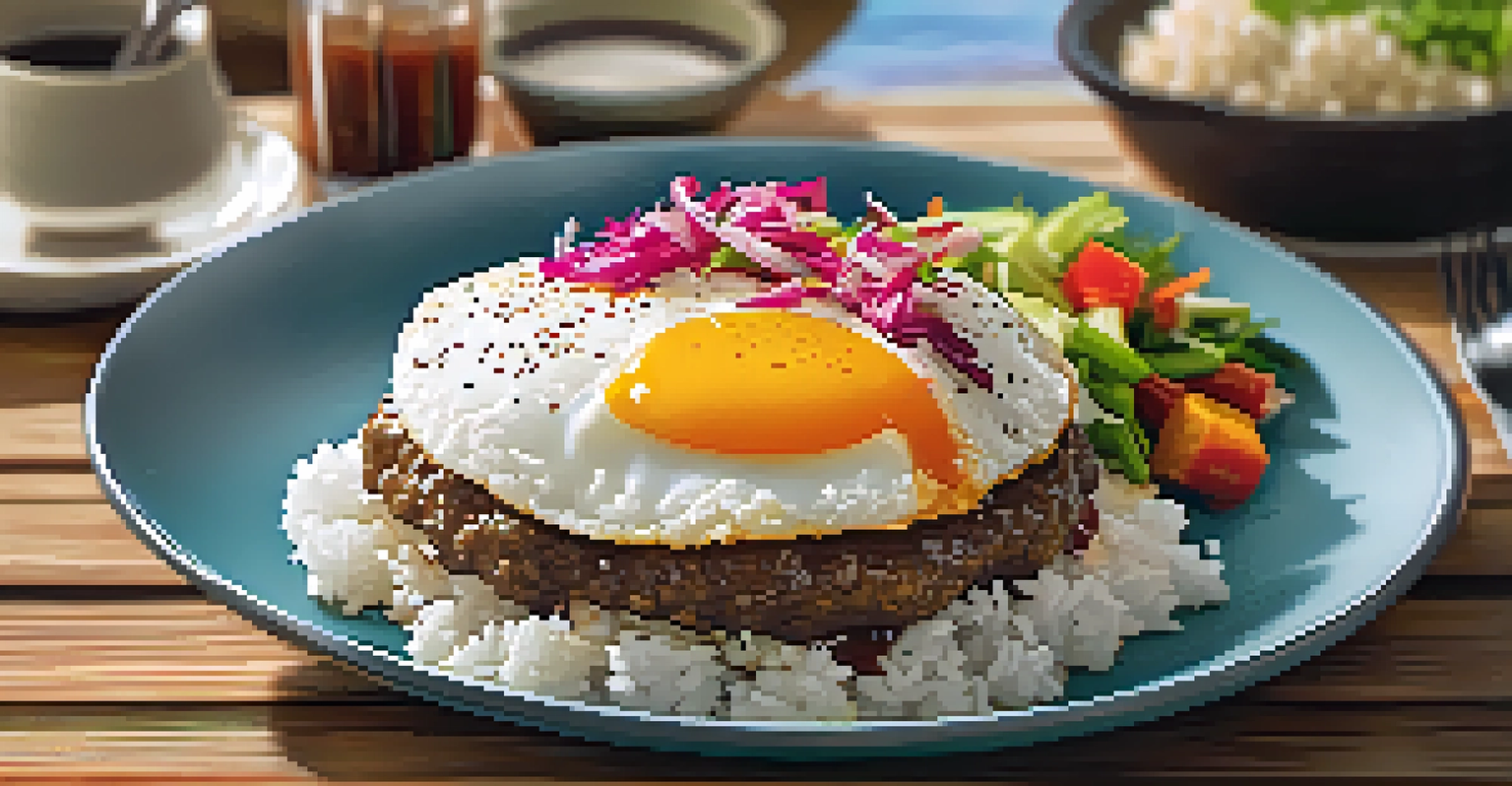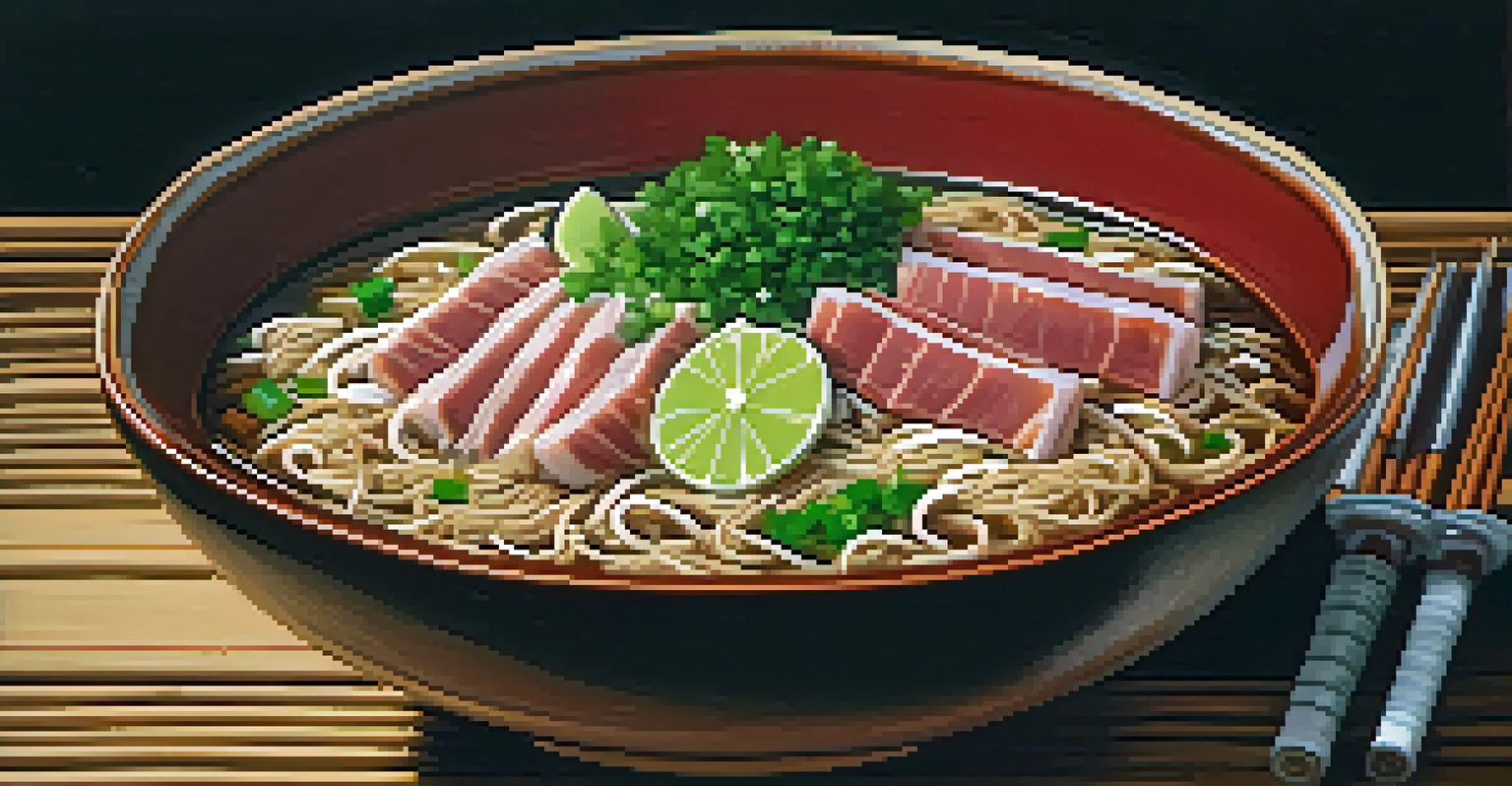The Influence of Asian Cuisine on Hawaiian Food Culture

A Brief Overview of Hawaii's Culinary Landscape
Hawaii's food culture is a vibrant tapestry woven from various influences, including native Hawaiian, Asian, and Western cuisines. This blend creates a unique culinary identity that reflects the islands' rich history and multicultural population. From the traditional poi to modern poke bowls, the evolution of Hawaiian cuisine is a story of adaptation and innovation.
Food is not just what we eat; it's a reflection of who we are and where we come from.
The warm climate and abundant natural resources of Hawaii have allowed diverse ingredients to flourish, setting the stage for an eclectic food scene. Fresh fish, fruits, and vegetables are staples, but it's the influence of Asian cuisine that truly adds depth to the flavors. This melding of traditions is not just about food; it's a celebration of the diverse cultures that have settled in Hawaii.
As we explore the influence of Asian cuisine on Hawaiian food culture, we'll uncover how these culinary traditions have shaped local dishes, created new flavor profiles, and fostered a sense of community through shared meals.
Historical Roots of Asian Influence in Hawaii
The historical ties between Asia and Hawaii date back to the 19th century, when immigrant laborers arrived to work on sugar plantations. These workers brought their culinary traditions, which began to blend with local ingredients and cooking methods. This exchange laid the groundwork for the diverse food culture we see today.

Chinese immigrants were among the first to make a significant impact, introducing dishes like chow mein and dim sum that have since become staples in Hawaiian cuisine. Their influence can be seen in the popular local dish, loco moco, which combines rice, a hamburger patty, fried egg, and gravy—showcasing an adaptation of flavors from multiple cultures.
Culinary Fusion in Hawaii
Hawaii's food culture is a vibrant fusion of native Hawaiian, Asian, and Western cuisines that reflects the islands' rich multicultural history.
Japanese immigration also played a crucial role in shaping Hawaiian food. The introduction of sushi, teriyaki, and shoyu (soy sauce) created a new wave of culinary fusion that has led to unique dishes like poke, which highlights fresh fish marinated with soy sauce and other Asian flavors.
The Role of Chinese Cuisine in Hawaiian Dishes
Chinese cuisine has left an indelible mark on Hawaiian food culture, especially with dishes that are both comforting and flavorful. The iconic saimin, a noodle soup, is a perfect example of this influence, combining elements from Chinese wheat noodles with local flavors and ingredients. It's a beloved staple that embodies the spirit of Hawaiian comfort food.
Cuisine is a blend of culture, history, and community, where every dish tells a story.
Another popular dish is the famous char siu, or Chinese barbecued pork, which has been adapted to suit local tastes. Served in various forms, from sandwiches to rice plates, char siu demonstrates how traditional Chinese cooking methods have been embraced and reinterpreted in Hawaii. This dish is a shining example of culinary adaptation and fusion.
The influence of Chinese cuisine extends beyond individual dishes; it has also shaped dining culture in Hawaii. Family-style dining, where dishes are shared among the table, is a hallmark of both Chinese and Hawaiian meals, promoting a sense of community and togetherness that is integral to both cultures.
Japanese Cuisine's Lasting Impact on Hawaiian Food
Japanese cuisine has significantly shaped Hawaii's culinary landscape, with many local favorites reflecting this influence. The popularity of sushi and sashimi in Hawaii is a testament to this cultural exchange. Many sushi restaurants in Hawaii have incorporated local fish, creating unique rolls that celebrate the islands' bounty.
Beyond sushi, dishes like teriyaki and tempura have become staples in Hawaiian households. Teriyaki chicken, for instance, is often found at potlucks and family gatherings, showcasing how Japanese flavors have been embraced by local communities. These dishes are not only delicious but also symbolize the blending of cultures.
Asian Influences Shape Local Dishes
The arrival of Asian immigrants, particularly from China and Japan, significantly influenced Hawaiian dishes, leading to unique adaptations like loco moco and poke.
Moreover, the concept of bento, or Japanese lunch boxes, has been adopted in Hawaii, leading to the creation of local variations that include rice, meat, and vegetables. This seamless integration of Japanese cuisine into Hawaiian meal preparation reflects the islands' unique food culture and highlights the importance of cultural exchange.
Korean Cuisine's Flavorful Contributions to Hawaii
Korean cuisine has also made significant contributions to the diversity of Hawaiian food culture, particularly through dishes like kalua pork and kimchi. Kalua pork, traditionally cooked in an underground oven, has been adapted for modern cooking methods but retains its smoky flavor and tender texture, making it a favorite at luaus and gatherings.
Kimchi, a staple in Korean cuisine, has found its way into many Hawaiian dishes, adding a spicy, tangy kick. This fermented vegetable dish complements a variety of meals, from barbecue to fried rice, showcasing the versatility of Korean flavors. The incorporation of kimchi into local cuisine has created a new layer of flavor that enhances traditional Hawaiian dishes.
The growing popularity of Korean barbecue in Hawaii also highlights the fusion of these two cultures. Restaurants offering Korean barbecue provide a communal dining experience where diners grill their own meats, fostering a sense of togetherness that resonates with Hawaiian hospitality.
The Influence of Southeast Asian Flavors in Hawaii
Southeast Asian cuisine has also left its mark on Hawaiian food, particularly through the introduction of Thai and Vietnamese flavors. Dishes like pho and pad Thai have gained popularity, often incorporating local ingredients that enhance their appeal. These dishes have become integrated into the local food scene, showcasing the adaptability of Hawaiian cuisine.
The use of fresh herbs, chilies, and spices in Southeast Asian cooking complements the fresh produce available in Hawaii. For instance, the addition of lemongrass and lime leaves adds a unique twist to traditional Hawaiian dishes, making them even more vibrant and flavorful. This fusion creates a culinary landscape that is both diverse and dynamic.
Modern Culinary Innovations
Today's chefs in Hawaii are creatively blending traditional flavors with modern techniques, resulting in innovative dishes like poke tacos and sushi burritos.
Street food culture from Southeast Asia has also influenced Hawaii, leading to the emergence of food trucks offering creative takes on traditional dishes. These food trucks not only celebrate the rich flavors of Southeast Asian cuisine but also reflect the innovative spirit of Hawaii's food culture.
The Modern Fusion of Hawaiian and Asian Cuisine
Today, the fusion of Hawaiian and Asian cuisine is more vibrant than ever, with chefs experimenting and creating innovative dishes that honor tradition while pushing boundaries. This modern culinary landscape reflects the islands' diverse influences and showcases the creativity of local chefs. From poke tacos to sushi burritos, the possibilities are endless.
Food festivals and fusion restaurants are popping up across Hawaii, celebrating this blend of flavors. These events provide a platform for chefs to showcase their unique interpretations of traditional dishes, allowing locals and visitors alike to experience the best of both worlds. It's a culinary celebration that fosters creativity and collaboration.

As the food scene continues to evolve, it's essential to recognize the cultural significance behind these culinary fusions. Each dish tells a story of migration, adaptation, and community, reminding us that food is not just about sustenance but also about connection and shared experiences.